If you live in south Florida, you probably have a pool. And if you live with little ones, you probably have a fence screening that pool from unwanted incursions by unwary feet. And if you’re interested in nature, you’ll soon discover that the fence does a remarkable job of collecting specimens, not just of dead leaves and other windblown wrack, but live specimens of new and exciting bugs (mostly bugs, a few dipterans, a lepidopteran or two) for a backyard naturalist. Today’s example ( a true bug) is a large and relatively conspicuous member of the family Pentatomidae (400 genera and some 5,000 species worldwide): Loxa flavicollis (Drury, 1793). The body is almost an inch long (around 20mm), and nearly as wide, with interesting “horns” projecting out from the “shoulders,” and a long series of “teeth” along the front edge of the pronotum:
The large, upward-pointing eyes, seen more clearly in the view below, remind me of a flounder or halibut:
I’ve seen other images of this bug on the web, and the shoulder spines are reddish; I’m not sure whether that comes with age or whether it’s a sex-marked difference, but our bug certainly did not have much red in the pronotum.
L. flavicollis, like all pentatomids, is in the large and interestingly diverse order Hemiptera, the “true bugs.” According to Thomas Eisner, one of the most entertaining of entomological writers (and one of the ones we’ll miss the most, as he died in March of this year, see the obit in the NY Times),
The mouthparts of hemipterans characteristically are formed into a rostrum or proboscis, specialized for fluid uptake. A number of hemipteran families, notably the Coreidae, or leaf-footed bugs, and the Pentatomidae, or stink bugs, have defensive glands from which they eject strongly odorous fluids when disturbed.
Eisner made his living analyzing the defensive behaviors and secretions of insects so he’s quite familiar with the chemical makeup and application techniques of this group of insects. The passage above is from one of his last books, Secret Weapons; he also writes about this family of insects in his other great recent work, For Love of Insects:
The beak contains two channels, one for the uptake of food, the other for the output of saliva. Hemipterans have diverse feeding habits. Some are insect killers, a few are bloodsuckers, and the majority, like most Pentatomidae, are plant feeders. All imbibe liquids only….
Stink bugs derive their name from the defensive secretion they eject when disturbed. In the immatures (the nymphs) the glands open on the dorsal surface of the abdomen, an area which in the adult is covered by the wings. Not surprisingly, therefore, adults have a different glandular arrangement. They possess a single large gland, situated midventrally in the thorax, with two separate openings on the sides of the body just above the legs.
If you click on the photo below, you might be able to make out a light dot or divot on the “belly” of the bug, just between and above the second and third pair of legs; I’m not sure (since I didn’t realize it would be important until after the bug had left), but I think that’s the “stink gland” opening:
According to Eisner, most stink bugs (and I presume this one is no exception) “can discharge separately from the right and left gland openings and they tend to restrict their discharge to one opening if the disturbance is unilateral” (Eisner 2003, 233). I, being slightly entomophobic despite my fascination with bugs, haven’t really put this ability to the test, nor did I when I encountered this specimen. If I had, presumably I would have said something like “ewwww,those simple straight chain aldehydes and ketones are stinky!”
Back when I was a lad in Sylmar, California (home of the ’71 quake), the black “stink bugs” (actually darkling beetles, Tenebrionidae) at our elementary school would stand on their heads and discharge when sufficiently messed with; I hadn’t gotten around to reading Eisner’s work, so I didn’t know how to appreciate the smell back then. But smelling it as I did then, I had very little desire to repeat the experience now that I have read my Eisner. So our stink bug from the fence was able to rest, in peace except for a camera lens pointed his way now and then.
Eisner’s discussion of the defensive secretions of pentatomids occurs in the context of spiders’ ability (or lack thereof) to distinguish prey items. The two examples he chooses are familiar Florida spiders: our famous “banana spider,” Nephila clavipes, and the silver orbweaver, Argiope florida. The silver orbweaver apparently treats stink bugs the same way they treat other insects with noxious defenses: it wraps ’em up, spinning ’em lengthwise, without making the bug nervous enough to discharge (!), so that only when it sinks its fangs in does the bug release, futilely, its defensive arsenal. Not one single stink bug ever escaped from Eisner’s Argiope spiders.
The banana spider, on the other hand, while fully capable of noticing that these bugs needed to be handled differently, had a different, and somewhat less successful hunting style. It always bites its prey first, rather than wrapping it up and immobilizing it. Nevertheless, these spiders did always try to position the bug so that its stink jets pointed away from the spider, but it wasn’t always successful, and got sprayed. What’s more, if it succeeded in spraying the spider thoroughly enough to give it a moment’s respite, the chemicals in the stink juice actually helped the bug dissolve the spider silk and make good its escape! The vast majority of bugs wound up eaten anyway (only 5 of 29 bugs eventually got away), but it is interesting to know that the same stinky chemicals that make the spider back off are also capable of disrupting the integrity of the spider’s silk.
Eisner’s book has some illustrations that I found rather interesting:
Does the unidentified pentatomid bug on the left of Eisner’s page look familiar? I can’t be 100% certain, since I haven’t found the paper on which the popular account in For Love of Insects is based, but to me it looks an awful lot like our Loxa! Here’s a closer look:
See those serrations on the fore-edge of the pronotum? See the shoulder prongs (not very clearly)? I would bet that we’re looking at the giant stink bug that I found on my pool fence the other day. What clinches it for me are the big eyes and the shape of the “mouth”; most of the other stink bugs have small little eyes and a tiny beak, but Loxa is huge (relatively speaking, of course).

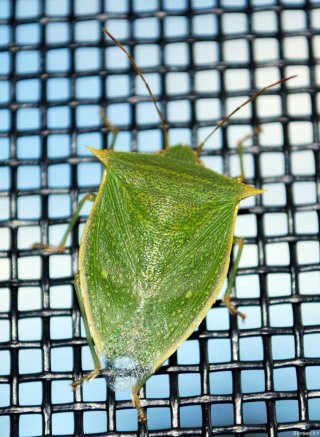
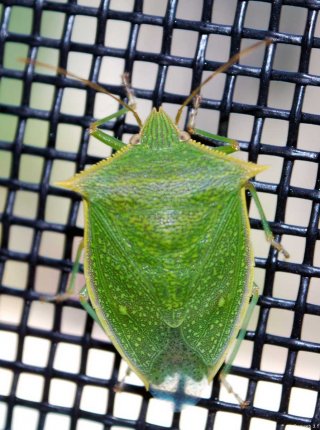
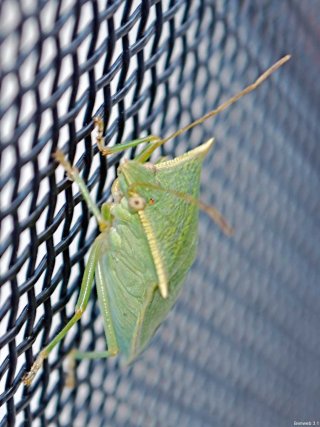
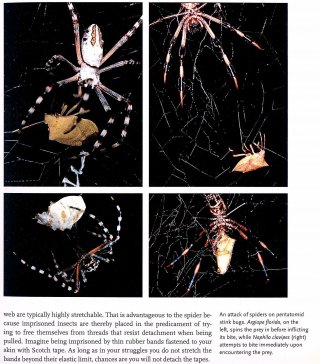
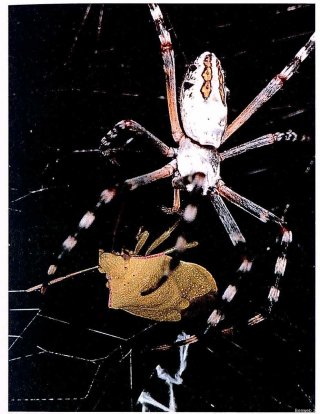
1 thought on “New backyard bug: Loxa flavicollis (probably)”